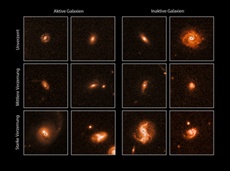Black Holes: galactic mergers not major feeding mechanism for mass monsters
10 Jan 2011
A new study has obtained unexpected new insight into the feeding habits of the giant black holes, which are responsible for the emissions of some of the brightest objects in the universe: active galactic nuclei.
 |
| If major mergers are an important factor in transporting matter towards galaxies' central black holes, which makes the black hole shine out brightly as an Active Galactic Nucleus (AGN), then distortions - the tell-tale traces of such mergers - should be more frequent for active galaxies (left) than inactive ones (right). |
Previous models had often assumed that mergers between galaxies are instrumental in driving matter into these black holes. But this systematic study of 1400 galaxies - the largest sample ever examined for the purpose - presents strong evidence that, at least for the past eight billion years, black holes have acquired their food more peacefully. (Astrophysical Journal, January 10, 2011)
The emissions of active galactic nuclei (AGN) are driven by matter falling into the galaxy's super-massive central black hole. But it is an open question in the physics of active galaxies how matter traverses the final hundreds of light-years to reach the immediate neighborhood of the black hole and be swallowed.
Following a study by David Sanders and collaborators from the late 1980s, most astronomers thought they had the answer: Mergers between galaxies of similar sizes ("major mergers") would dramatically disturb the galaxies' gas, and make some of it fall towards the central black hole.
While this is a plausible scenario, only a systematic study can show whether or not this is indeed how giant black holes acquire their food.
This is what Mauricio Cisternas and Knud Jahnke from the Max Planck Institute for Astronomy (MPIA) set out to do in 2008. Cisternas explains: "A study of this scope has become possible only recently, with the large surveys undertaken using the Hubble Space Telescope. Before, there was simply no way to examine sufficiently many active galaxies at large cosmic distances in sufficient detail."